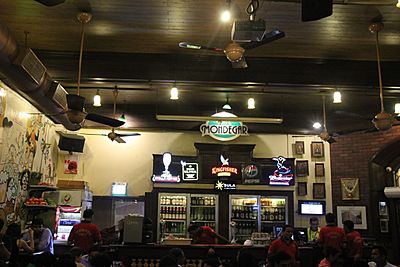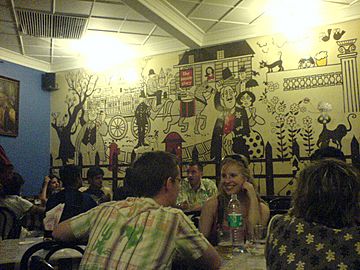Mario Miranda facts for kids
Quick facts for kids
Mario Miranda
|
|
|---|---|

Mario Miranda in 2008
|
|
| Born |
Mário João Carlos do Rosário de Brito Miranda
2 May 1926 |
| Died | 11 December 2011 (aged 85) Loutolim, Goa, India
|
| Nationality |
Portuguese (formerly)
|
| Education | Bachelor of Arts in History |
| Alma mater |
St Joseph's Boys' High School, Bangalore
St. Xavier's College, Mumbai |
| Occupation |
|
| Known for | Cartoonist for The Illustrated Weekly of India |
| Spouse(s) | Habiba Hyderi de Miranda |
| Family | Tyabji–Hydari family (through wife) |
| Awards |
|
Mário João Carlos do Rosário de Brito Miranda (2 May 1926 – 11 December 2011), known as Mario Miranda, was a famous Indian cartoonist and painter. He lived in Loutolim, a village in Goa, India.
Mario Miranda was a regular artist for The Times of India and other newspapers in Mumbai. He became very popular for his work in The Illustrated Weekly of India. He received India's second highest civilian award, the Padma Vibhushan, after he passed away in 2012.
Contents
Life and Career of Mario Miranda
Early Life and Artistic Beginnings
Mario Miranda was born in Daman, which was then part of Portuguese India. From a very young age, he loved to draw. He would sketch funny pictures and drawings on the walls of his home. His mother gave him a blank book to draw in.
In the 1930s and 1940s, he started making special postcards for his friends. He would charge a small fee for them. He even got into trouble at school for drawing pictures of Catholic priests. Mario's early cartoons often showed scenes of village life in Goa. He kept diaries from the age of 10, filling them with sketches of everything around him.
He went to St. Joseph's Boys' High School, Bangalore. Later, he studied history at St. Xavier's College, Mumbai. His parents wanted him to study architecture, but he soon lost interest. He started getting small jobs to draw and kept sketching people in his private diaries in 1949. He enjoyed visiting restaurants and taverns to draw the people there.
Starting a Career in Cartooning
Mario Miranda began his career in an advertising studio. He worked there for four years. After that, he became a full-time cartoonist. His first big chance came when The Illustrated Weekly of India published some of his drawings.
His cartoons also led to an offer to work at Current magazine. A year later, The Times of India offered him a job, even though they had first said no. Soon, his famous characters, like Miss Nimbupani and Miss Fonseca, appeared regularly. They were seen in Femina, Economic Times, and The Illustrated Weekly of India.
Mario then won a special grant and lived in Portugal for a year. This helped him see more of the world. He then moved to London, where he worked for different newspapers. He even worked in television animation. During his five years in London, his drawings were published in magazines like Mad, Lilliput, and Punch. He traveled to many countries, working or holding art shows.
Return to India and Recognition
Mario Miranda returned to India in the late 1980s. He got his old job back with The Times of India in Mumbai. There, he worked with another famous cartoonist, R. K. Laxman.
Later, Mario met artist Habiba Hydari. They got married and had two sons, Rahul and Rishad.
A big moment for Miranda came in 1974. He was invited to travel to America. This trip helped him share his art and meet other cartoonists. He even got to work with Charles M. Schulz, who created the Peanuts comic strip. He also met Herblock, a well-known cartoonist for the Washington Post.
Mario Miranda held solo art shows in more than 22 countries. These included the United States, Japan, Brazil, Australia, Singapore, France, and Portugal.
Later Years and Passing Away
After retiring, Mario Miranda lived in his family home in Loutolim, Goa. He lived there with his wife, Habiba. Even after retirement, his work was still seen in Mumbai newspapers. He was also invited to travel to countries like Mauritius and Spain to draw their local cultures.
Mario Miranda passed away peacefully at his home in Loutolim on December 11, 2011.
Mario Miranda's Unique Art Style
Mario Miranda's most popular cartoon style was "very flat with criss-crossing interactions." This means his drawings showed many people interacting in busy scenes.
He loved to observe people everywhere. He would draw them in restaurants, taverns, at weddings, bus stops, and post offices. He captured their social lives in his art. However, he always avoided drawing political cartoons.
Art critics describe his work as subtly witty. His drawings told stories through shapes and lines. His "geometric jiggles" and soft colors helped show the feelings of his characters. His artworks often included people from all parts of life interacting with each other. He also captured the true spirit of Goan life.
Beyond Cartoons: Murals and Books
Besides cartooning, Mario Miranda also created large paintings called murals. These murals can be seen on various buildings in Goa and other parts of India. Later in his life, he started painting, and his artworks were very popular.
Over the years, he published several books of his own. These include Laugh it Off, Goa with Love, and Germany in Wintertime.
He also drew pictures for books by other writers. He illustrated books like A Journey to Goa by Dom Moraes. He also illustrated many children's books. These included Dul-Dul, The Magic Clay Horse and The Adventures of Pilla the Pup.
In 1951, he worked with a Sanskrit scholar and an IAS officer. They published a special issue of Marg magazine about Goan art and culture.
He loved to travel and listen to music. He had hoped to experiment more with watercolors and write about his early years in Goa after retirement. Sadly, he was not able to do these two things.
In the 1990s, the owner of Café Mondegar in Mumbai asked Mario Miranda to draw murals on two of its walls. One wall shows Life in Mumbai, and the other shows the Atmosphere in the Café.
- Murals
In 2004, when the new market in Panjim opened, Miranda was asked to paint a mural on its walls. He was so happy with the new market that he refused to charge the government for his work.
Legacy and Honors
Mario Miranda's house was featured in the 1985 film Trikaal by Shyam Benegal. The film was inspired by Miranda's family and home.
In 2005, Gerard da Cunha started working on a book about Mario Miranda. He collected 13,000 of Miranda's artworks from different places. In 2016, a large exhibition of Mario de Miranda's original cartoons and paintings was held in Panaji. A book called The Life of Mario: 1949 was also released. It was a collection of drawings Mario made when he was 23 years old.
Awards and Special Recognition
Mario Miranda received many honors for his amazing work.
- In 1988, he was part of the national integration video "Mile Sur Mera Tumhara". This video featured many famous Indians.
- He received the Padma Shri award in 1988.
- He received the Padma Bhushan award in 2002.
- The All India Cartoonists's Association in Bangalore gave him a lifetime achievement award.
- In 2009, the King of Spain gave Mario a high civilian honor called the "Cross of the Order of Isabel the Catholic".
- In 2009, Portugal made him "Commander of the Order of Prince Henry", a Portuguese national honor.
- After his death, in 2012, he was given the Padma Vibhushan. This is India's second highest civilian award.
After he passed away in 2011, the Goa Legislative Assembly honored him in March 2012. In 2013, a road junction in Mumbai was named after Mario Miranda. In May 2016, Google honored him with a special doodle on his 90th birthday. The doodle showed a typical Mumbai street scene during the rainy season.




